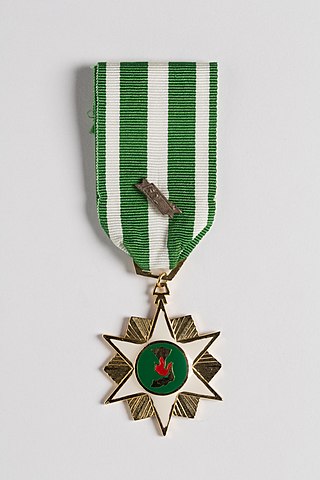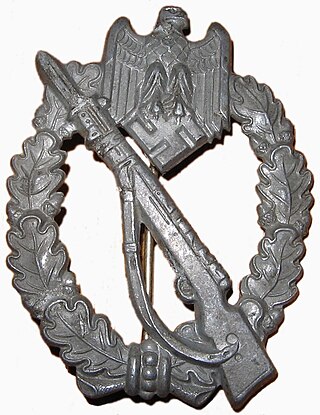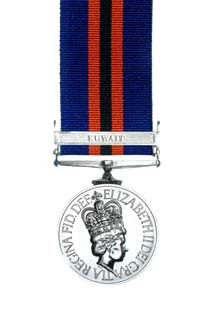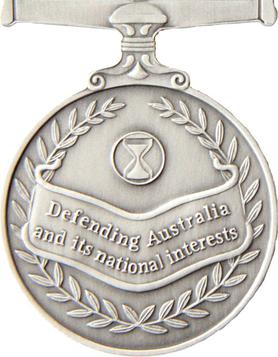The Australian honours and awards system refers to all orders, decorations, and medals, as instituted by letters patent from the Monarch of Australia and countersigned by the Australian prime minister at the time, that have been progressively introduced since 14 February 1975. The Australian honours and awards system excludes all state and local government, and private, issued awards and medals.

The Combat Infantryman Badge (CIB) is a United States Army military decoration. The badge is awarded to infantrymen and Special Forces soldiers in the rank of colonel and below, who fought in active ground combat while assigned as members of either an Infantry or Special Forces unit of brigade size or smaller at any time after 6 December 1941. For those soldiers who are not members of an infantry, or Special Forces unit, the Combat Action Badge (CAB) is awarded instead. For soldiers with an MOS in the medical field they would, with the exception of a Special Forces Medical Sergeant (18D), receive the Combat Medical Badge. 18D Special Forces Medics would receive the Combat Infantryman badge instead.

The Republic of Vietnam Campaign Medal, also known as the Vietnam Campaign Medal, is a South Vietnamese military campaign medal which was created in 1949, and awarded to French military personnel during the First Indochina War. During the Vietnam War, the South Vietnamese government awarded the Republic of Vietnam Campaign Medal with Device to members of the South Vietnamese military for wartime service and on March 24, 1966, to members of the U.S. military for support of operations in Vietnam. In May 1966, other allied foreign military personnel became eligible for the award.
To be mentioned in dispatches describes a member of the armed forces whose name appears in an official report written by a superior officer and sent to the high command, in which their gallant or meritorious action in the face of the enemy is described.

The Combat Action Badge (CAB) is a United States military award given to soldiers of the U.S. Army of any rank and who are not members of an infantry or special forces MOS, for being "present and actively engaging or being engaged by the enemy, and performing satisfactorily in accordance with prescribed rules of engagement" at any point in time after 18 September 2001.

The Australian Active Service Medal (AASM) is an Australian military decoration. It was authorised on 13 September 1988 to recognise prescribed service in "warlike" operations, backdated to February 1975. It is awarded with a clasp to denote the prescribed operation and subsequent awards of the medal are made in the form of additional clasps. In 2012, it was announced that the medal would no longer be issued for future operations, with the AASM and the Australian Service Medal being replaced by the Australian Operational Service Medal.

The Kuwait Liberation Medal is a medal created in 1994 that was issued by the government of Kuwait to both local and foreign military personnel who served in the Persian Gulf War's "Liberation of Kuwait" campaign phase of 1990 and 31 August 1993.

This is a list of Norwegian orders and medals, in order of precedence. This list contains all medals approved for wearing on a Norwegian military uniform in ranked order.

The Infantry Assault Badge was a German military decoration awarded to Waffen-SS and Wehrmacht Heer soldiers during the Second World War. This decoration was instituted on 20 December 1939 by the Commander-in-Chief (Oberbefehlshaber) of the German Army, Generalfeldmarschall Walther von Brauchitsch. It could be awarded to members of infantry and Gebirgsjäger units that had participated in infantry assaults, with light infantry weapons, on at least three separate days of battle in the front line on or after 1 January 1940. When a counter-offensive led to fighting, it could also apply. Award of the Infantry Assault Badge was authorized at regimental command level, and mechanized or motorized infantry were not eligible for the original badge. A bronze variant of the Infantry Assault Badge was created in June 1940, authorized for motorized and mechanized infantry units, using similar requirements for award as the original silver variant. Non-infantry personnel were not eligible for either grade of the Infantry Assault Badge, but were eligible for other combat recognition badges, usually the General Assault Badge, Close Combat Clasp, or the Panzer Badge. The Luftwaffe would develop its own ground combat badge in 1942, the Ground Assault Badge.
The Distinguished Service Cross (DSC) is a military decoration awarded to personnel of the Australian Defence Force. It is awarded for distinguished command and leadership in action. The DSC was introduced in 1991 and is the highest distinguished service decoration in the Australian Honours System. Recipients of the Distinguished Service Cross are entitled to use the post-nominal letters "DSC". Since its inception 115 awards have been made—which includes eight first Bars and one second Bar.
The Star of Gallantry (SG) is a military decoration awarded to personnel of the Australian Defence Force (ADF) and other persons recognised by the Minister for Defence. It is awarded for acts of great heroism or conspicuous gallantry in action in circumstances of great peril. It is the second highest of the military gallantry awards in the Australian Honours System, only surpassed by the Victoria Cross or Victoria Cross for Australia (VC).

The New Zealand General Service Medal 1992 (Warlike) (NZGSM 1992) is a New Zealand campaign medal, authorised in 1992, for award to New Zealanders who have served in warlike operations for which no separate New Zealand or British Commonwealth campaign medal was issued.

The Iraq Medal was authorised on 23 February 2004. It was a campaign medal issued to members of the British Armed Forces and certain attached personnel, who served between 20 January 2003 and 22 May 2011 on, or in support of, Operation Telic - the designation for British operations during the 2003 Invasion of Iraq and its aftermath.
The Nursing Service Cross (NSC) is a conspicuous service decoration of the Australian honours and awards system, instituted by Letters Patent on 18 October 1989.

The Australian Active Service Medal 1945–1975 recognises the service of Australian Defence Force and certain other persons in prescribed warlike operations in the period after World War II, and prior to February 1975. The medal was established in December 1997. The Australian Active Service Medal recognises warlike service after February 1975 until 2012 when the Australian Operational Service Medal was instituted.

The Australian Service Medal is an Australian military decoration. It was authorised 13 September 1988 to recognise prescribed service in peacekeeping and non-warlike operations. It is awarded with a clasp to denote the prescribed operation and subsequent awards of the medal are made in the form of additional clasps. The Australian Service Medal 1945–1975 recognises non-warlike service prior to February 1975. The Australian Service Medal was replaced in 2012 by the Australian Operational Service Medal, except for ongoing missions.

The Infantry Combat Badge (ICB) is awarded to serving members of the Australian Army for service as an Infantryman in warlike operations.

The New Zealand Distinguished Service Decoration (DSD) was instituted by Royal Warrant as a New Zealand Royal Honour in 2007 to recognise distinguished military service, by regular, territorial and reserve members of the New Zealand Defence Force. Until 1995, this type of service was recognised by awards of the British Empire Medal (Military Division). After the change to a totally New Zealand Honours system in 1996, these Commonwealth awards were not available to be awarded to New Zealand military personnel.
The Armed Forces of India are eligible for many military decorations awarded for extraordinary bravery and distinguished service during times of war and peace. Service and campaign medals have been awarded throughout India's history as an independent state.

The Australian Operational Service Medal is a campaign medal established on 22 May 2012 to recognise service by Australian Defence Force (ADF) personnel on designated hazardous operations. It may also be awarded to civilians who serve alongside the ADF on designated operations under specific conditions.














